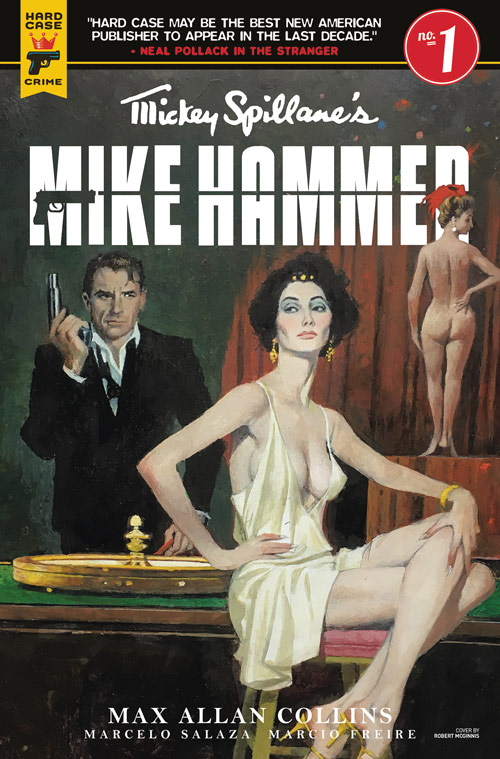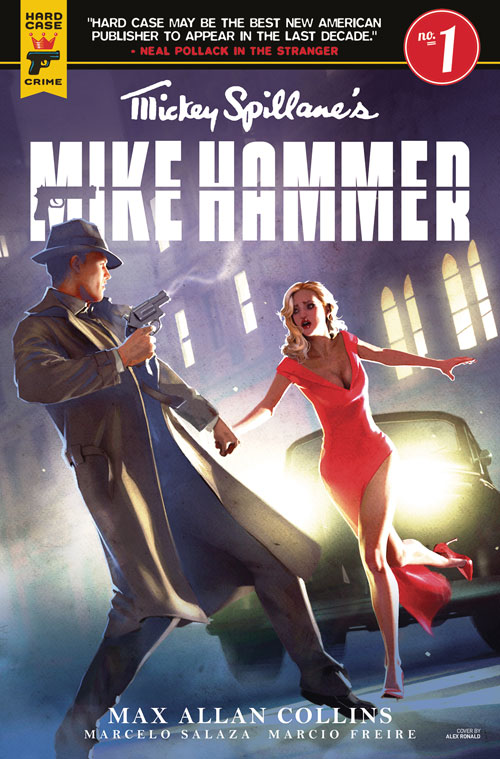Max Takes Over Mickey’s Mike Hammer
Jun 23, 2018
 |
by Vince Brusio
Mickey Spillane was the first writer to take a detective and make him into a superhero. Not that his protagonist was adorned in a cape and cowl. No, his leading man, instead, suited up in a fedora and trench coat. And his crimebuster didn’t have super powers. But he was a ruthless avenger. God help you if you got on his bad side. It is a time where PC would have been thrown in the deep sea. It is the 1960s. Doctors smoked in front of their patients. And detectives depended on derelicts to get the goods on what slimeballs were doing illegal activities under the cover of darkness. You will experience this window through time in Mickey Spillane’s Mike Hammer #1 (APR181769) from Titan Comics. It’s a mini-series that’s written by one of Spillane’s closest friends, and only one of a handful of writers (minus four fingers) could have pulled it off. Which is why Max Allan Collins got the gig. Because Max knows what to do. In this PREVIEWSworld Exclusive interview, Collins spills his guts on what makes this story a natural fit for Titan’s Hard Case Crime comics.
Mickey Spillane’s Mike Hammer #1 (APR181769) is in comic shops June 27.
**********
Vince Brusio: For those readers who may be new to the “Hard Case Crime” release of Mickey Spillane’s Mike Hammer #1, tell us about the history behind Spillane’s detective, and how he came to have a home in your hands so that you could write this four-issue series?
Max Allan Collins: Mickey, as I'm sure you know, was a Golden Age comics scripter who worked on Captain America, Sub-Mariner and many other classic characters. Just before he went into the service, he created the Hammer character for comics, initially calling him "Mike Lancer," with a story appearing in a Green Hornet issue. After the war, he tried to market the character for comics as "Mike Danger," but didn't find any takers, though a few years later the sample stories turned up in two issues of an obscure comic book, Crime Detector. Mickey retooled the character for a prose mystery, writing the famous bestseller I, The Jury in a matter of days. The novel didn't do much in hardcover, but its amazing success in paperback led to countless imitations and sparked the whole paperback original trend.
I have been a fan of Mickey's since I was 13, and we became friends in the early '80s, after I became established as a mystery writer myself. We collaborated on many projects — a dozen anthologies of noir fiction by himself and his peers, a comic book Mike Danger, which took the prototype of Hammer into s-f areas (this was in the 1990s), and several movie projects, including my films Mommy, Mommy's Day and the documentary Mike Hammer's Mickey Spillane, featured on the Criterion Collections release of the great Hammer film, Kiss Me Deadly (1955).
A few days before his death, Mickey asked me to complete the Hammer novel he was almost finished with, The Goliath Bone, and then instructed his wife Jane that all of his unpublished, unfinished material should be given to me — "Max will know what to do." I've completed a dozen novels of his now and around a dozen more short stories.
Vince Brusio: We’re given a story that has its roots in a plot from Mickey Spillane. Is this an unpublished plot? Why did you choose to work with it? How do you embrace it? How do you change it? How is it ideal for a comic treatment?
Max Allan Collins: Mickey did several versions of this story — one for radio, another a TV movie, plus supervised my writing of a feature film screenplay around when we were doing the Mike Danger comic book. I drew on the latter two versions of the story for the serialized graphic novel, which represents its first publication from that material. Obviously the story had to be reorganized into a four-issue structure, but the TV-movie and feature film scripts I used were of course visually-oriented and made ideal material.
Vince Brusio: Tell us about the faces in this story. Who are the supporting characters? Are they archetypal shadows in the night amid the drooling derelicts in street alleys? How did you envision their personalities, and dress them in your mind to the point where you could smell their breathing, right down to their brands of cigarettes and brandy?
Max Allan Collins: Hammer's supporting cast is small but key — Velda, his secretary and love-of-his-life; and Pat Chambers, his cop pal and sometime adversary. We do have an alley-dwelling derelict, though he doesn't drool. The cast is typical noir — gangsters, femme fatales, thugs, a down-on-his luck Broadway columnist — but we take them to typically Spillane extremes. Mickey brought sex and violence to the detective story in an all-new way, and was the first writer to make a series hero out of a ruthless avenger.
Vince Brusio: As it appears that we’re taken back to a time before there was color television, how did you research the norms of the period’s syntax, so that when we’re reading the dialogue it appears genuine to everyday street talk?
Max Allan Collins: I have written literally dozens of detective and crime novels with a mid-Twentieth Century time frame and setting -- my Nathan Heller historical thrillers particularly. It comes naturally to me now. I believe this story is early '60s, fairly deep into Hammer's career. But the feel is probably more '40s/'50s. It's not a matter of everyday street talk, but the noir poetry of the kind of tough melodrama Mickey specialized in. This is no more realistic than a super-hero story — Mike Hammer is a kind of super-hero. He just wears a fedora and a trench coat, not a cape and cowl.
Vince Brusio: What makes it a thrill for you to write this story? What do you get out of it? What is it about the makeup of Mike Hammer that makes you want to blow everything else off for the day so that you can just sit in front of the keyboard and type?
Max Allan Collins: Mickey used to say his inspiration came from "the urgent need for money." I have never had writer's block in my life, and like Mickey consider myself a pro who relishes a nice paycheck. That said, Hammer and Spillane were obsessions of my teen years and my enthusiasm for them propelled me into the mystery writing field. So it's a thrill, all right. Specifically with the comic book series, I relish having the opportunity to take this character back to his, and Mickey's, comics roots, without having to water down the tough violence and steamy sex. Back in the early '50s, Mickey wrote a syndicated comic strip version of Hammer that ran only about a year because the sex and violence got it prematurely cancelled. Nice to be able to take the gloves off in the medium Hammer was created for.
 |
 |
**********
Vince Brusio writes about comics, and writes comics. He is the long-serving Editor of PREVIEWSworld.com, the creator of PUSSYCATS, and encourages everyone to keep the faith...and keep reading comics.




